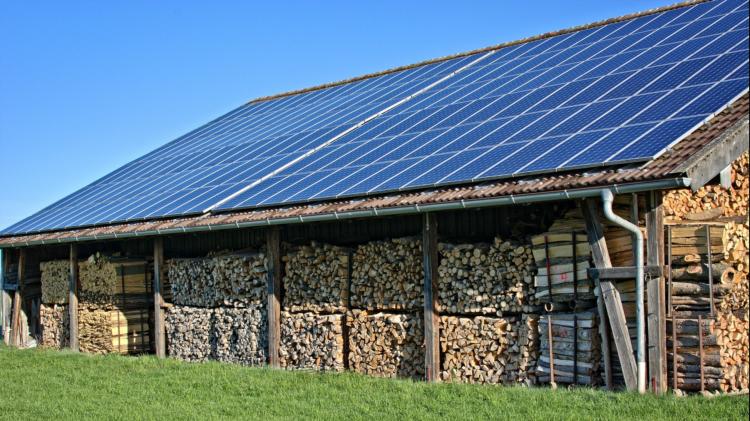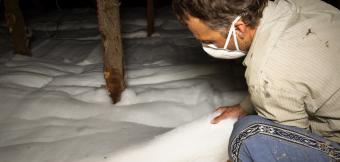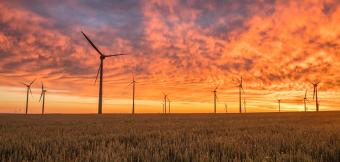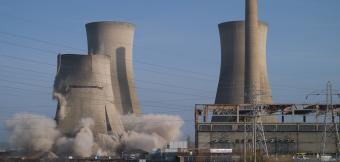
Change your heating
Room heating and hot water account for well over half of domestic energy consumption. Fully insulate your home and upgrade to an efficient modern heating system. If you use fossil fuels, consider changing to something with far lower emissions, such as wood/biomass, biogas, sunshine or a heat pump.

How much heat do you need?
In the long run, the cheapest and best option is to significantly reduce heat demand via energy efficiency. Before you invest in any new technology, find out how much energy you currently use and do all you can to reduce it (see Action 40: 'Warm your home efficiently'). Better insulation and an efficient boiler can halve heating needs in typical UK homes, twice the reduction from installing an air source heat pump. Best of all, do both; the highest insulation standards combined with heat pumps can reduce heating energy needs by 95%.
Fuel
The table below compares the carbon emissions of the main domestic fuels. Oil, liquid petroleum gas and coal have unacceptably high carbon footprints and should be replaced. Electricity is high carbon unless you use a renewable supplier or generate your own (for an explanation read Action 23: 'Choose renewable energy' and Action 10: 'Generate your own electricity'). Wood, heat pumps, geothermal, biogas and heat from the sun are all low-carbon choices.
|
Fuel
|
Efficiency
|
Grams of CO2 per Kilowatt hour |
Notes
|
|
Oil boiler
|
Least efficient |
550 |
Replace! |
|
Most efficient |
310 |
Replace! |
|
|
Coal |
360 |
Replace! |
|
|
Liquid Petroleum Gas |
|
230 |
Replace!
|
|
Electric heater
|
Electricity at 370 gms/ kwh
|
370
|
Entirely dependent on the carbon footprint of the electricity used...
|
|
|
Electricity at 100 gms/ kwh |
100
|
...so replace where you don't have access to low emission electricity.
|
|
Gas boiler |
Least efficient |
380 |
Replace! |
|
|
Most efficient |
210
|
Natural gas is the cleanest fossil fuel, and is cheap, efficient and easy to use. But it still emits a lot of CO2! |
|
Ground source heat pump |
Electricity at 370 gms / kwh
|
70-190
|
Uses electricity to bring warmth from outdoors inside. Produces 3-4 units of heat for every unit of electricity, much more efficient than electric or gas... |
|
|
Electricity at 100 gms / kwh |
20-50
|
...but more expensive than a new boiler, though grants may be available; it takes 5 to 15 years to pay for itself. |
|
Air source heat pump |
Electricity at 370 gms / kwh |
90-250
|
Cheaper and easier to install than a ground source heat pump, but less efficient. |
|
|
Electricity at 100 gms / kwh |
30-70
|
|
|
Biogas |
|
20-100 |
Bio-methane is generated from food waste in a bio-digester. See Action 45 'Use innovative technology' |
|
Biomass boiler |
Under 100 |
Good replacement for oil or coal, although a pellet boiler system is expensive to install. |
|
|
Geothermal
|
|
10
|
Unless you live near a volcano or hot spring, it’s not practical. If you do, it’s the perfect heat source. |
|
Solar thermal |
|
10-35 |
A system where pipes on the roof allow the sun to directly heat domestic hot water. (Not PV panels). |
|
Wood logs |
|
15
|
Wood is carbon neutral. But transport isn't, and smoke lowers air quality. Great if you have your own source of wood. |

Sunshine
A great carbon-neutral fuel source which is entirely free is sunshine. You can 'harvest' this by adding a solar greenhouse or conservatory to your home to capture and store the sun's heat (passive solar gain). Build it along the sunniest external wall of your house, allow the heat to circulate into your house, and add thermal mass to store the heat. Include venting and screens so it doesn't overheat in summer.
A simple ‘bread box’ solar water heater can be constructed from recycled materials. It consists of black tanks mounted inside an insulated box. The lid should be well sealed and of transparent glazing material. Cold water enters the tank near the bottom, heats and rises to the top where it is piped back into the home.
Heating systems
Which technology is best? There’s no definitive answer. It depends on your heating needs, the efficiency of the model you buy, the amount you spend, the local climate, your area’s power grid, and how well you maintain the system. Before you spend any money, research widely on-line and consider paying for professional advice.
Central heating radiators are expensive to install, depending on what system you are installing and the size of the property. However, the savings can be quite dramatic and they provide very good thermal comfort. Using mains gas, biomass, a heat pump or solar thermal will all generate significant savings. The best way to work out just how much is to employ an expert.
Underfloor heating is efficient because it turns the whole floor into a radiator. The large surface area means it doesn’t have to be a high temperature to warm the room. It can be expensive to install (especially if retrofitted) but uses 15-40% less energy than traditional radiators. Source.
District heating systems
Also known as heat networks, these generate heat in a central location then distribute it to multiple buildings. They are best suited to dense urban areas and new builds. Low-carbon heat sources can include waste heat, heat pumps, geothermal and bio-methane. Some European countries provide the majority of their energy from district heating.
Open fire/stove
These may look lovely but are generally inefficient and won't heat a whole house. An efficient wood stove with heat recovery and a back boiler might do the job, and you can cook on it as well. Rocket stoves are super efficient as they burn the smoke as well as the wood. When thermal mass (clay or bricks) is added to store and circulate the heat they can provide high thermal comfort.
Micro-CHP
Micro combined heat and power generates heat and electricity simultaneously, from a special boiler. A typical domestic system can generate up to 1kW of electricity per hour, enough to power the lights and appliances. It costs about double a conventional boiler, but generates free electricity.
A Buyers Guide to Renewable and Low Carbon Technologies
Picture credits: 1) TBI Toni - pixabay.com 2) Babin Shrestha - unsplash.com 3) Manfred Antranias Zimmer - pixabay.jpg
Do a home energy assessment
Replace fossil fuel with a low-carbon fuel source
Suggest neighbours and family follow your example
Campaign for subsidies for energy efficient home improvements



